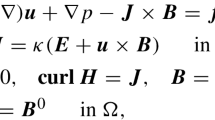Summary
We construct a space-centered self-adjusting hybrid difference method for one-dimensional hyperbolic conservation laws. The method is linearly implicit and combines a newly developed minimum dispersion scheme of the first order with the recently developed second-order scheme of Lerat. The resulting method is unconditionally stable and unconditionally diagonally dominant in the linearized sense. The method has been developed for quasi-stationary problems, in which shocks play a dominant role. Numerical results for the unsteady Euler equations are presented. It is shown that the method is non-oscillatory, robust and accurate in several cases.
Similar content being viewed by others
References
H. Araki et al., editors, Proc, 8th Int. Conf. on Num. Meth. in Fl. Dyn., Springer Leet. Notes in Phys. 170 (1982).
R. Beam and R.F. Warming, An implicit finite difference algorithm for hyperbolic systems in conservation law form, J. of Comp. Phys. 11 (1976) 87–110.
R. Courant and K.O. Friedrichs, Supersonic flow and Shock Waves, Springer, reprint (1976).
A. Harten and G. Zwas, Self-adjusting hybrid schemes for shock computations, J. of comp. Phys. 6 (1972) 568–583.
A. Harten, The artificial compression method for computation of shocks and contact discontinuities: III: Self-adjusting hybrid schemes, Math. of Comp. 32 (1978) 363–389.
D.N. Holla and P.C. Jain, Implicit dissipative schemes for solving systems of conservation laws, J. of Eng. Math. 13 (1979) 257–270.
E. Issacson and H. Keller, Analysis of Numerical Methods, Wiley (1966).
J. of Comp. Phys. 48 (1982) no. 2.
A. Lerat, Sur le calcul des solutions faibles des systèmes hyperboliques de lois de conservation à l'aide de schèmas aux diffèrences, thesis, Univ. Pierre et Marie Curie (1981). Also Publication ONERA 1981-1.
A. Lerat, J. Sidès and V. Daru, An implicit finite volume method for solving the Euler equations, Proc. 8th Int. Conf. on Num. Meth. in Fl. Dyn., ed. H. Araki et al., Springer (1982).
A. Lerat, private communication (1983).
A. Lerat, Implicit methods of second-order accuracy for the Euler equations, Proc. 6th AIAA Comp. Fl. Dyn. Conf. (1983).
J.H. Varah, On the solution of block-tridiagonal systems arising from certain finite difference equations, Math. of Comp. 26 (1972) 859–868.
P. Wilders, Minimization of Dispersion in Difference Methods for Hyperbolic Conservation Laws, Thesis, Univ. of Amsterdam (1984).
Author information
Authors and Affiliations
Rights and permissions
About this article
Cite this article
Wilders, P. An unconditionally stable implicit method for hyperbolic conservation laws. J Eng Math 19, 33–44 (1985). https://doi.org/10.1007/BF00055039
Received:
Issue Date:
DOI: https://doi.org/10.1007/BF00055039




